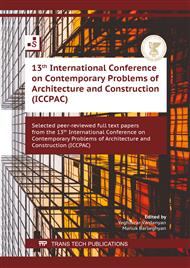[1]
Kiseleva E.G., Magkov M.S. Teplotehniceskij rascet ograzdausih konstrukcij zilyh i obsestvennyh zdanij: ucebno-metodiceskie ukazania k kursovoj rascetno-graficeskoj rabote po arhitekturnoj klimatologii. Dla studentov, obucausihsa po special'nosti <<Arhitektura>> I <<Dizajn arhitekturnoj sredy>>. - M.,: MARHI, 2012. - 36 s.
Google Scholar
[2]
Eremkin A.I., Koroleva T.I. Teplovoj rezim zdanij: Ucebnoe posobie. - M.: Izdatel'stvo ACB, 2000 - 368 s. [in Russian].
Google Scholar
[3]
Z. A. Melikyan, Heating–Cooling of Buildings. Efficiency of Conventional and Renewable Technologies LAP Lambert Academic Publishing, Germany (2012), 344 pages ISBN: 978-3-8443-1939-2.
Google Scholar
[4]
Peklov, A. A. Kondicionirovanie vozduha v promyshlennyh i obshchestvennyh zdaniyah / A.A. Peklov. - M.: Budivel'nik, (2016). - 296 s. [in Russian].
Google Scholar
[5]
Roger Legg, Air conditioning system design, Butterworth-Heinemann is an imprint of Elsevier (2017) Elsevier Ltd, 418 pages ISBN: 978-0-08-101123-2.
Google Scholar
[6]
Construction Norms RACN 24-01-2016 Thermal Protection of Buildings,, (2016) 63 pages ISBN 978-9939-1-0421-8.
Google Scholar
[7]
Hans Dieter Baehr, Karl Stephan, Heat and Mass Transer, Third Edition. Springer Heidelberg Dordrecht London New York (2011) 762 pages ISBN 978-3-642-20020-5.
Google Scholar
[8]
Construction Norms - ASHRAE – Fundamentals Chapter F01. / Mark S. Owen Editor. Psychrometrics (2013) 16 pages.
Google Scholar
[9]
M.G. Khmel`nyuk, D.I. Vazhinskij, N.V. Zhikhareva, Sovremenny`e tekhnologii osusheniya vozdukha, Refrigeration Engineering and Technology (2014) 15-21. [in Russian].
Google Scholar
[10]
E.P. Vishnevskij, Analiz ispol`zovaniya osnovny`kh metodov osusheniya vozdukha, Tekhnicheskij byulleten`. # 1. (2003) 4–6. [in Russian].
Google Scholar
[11]
V. V. Kozlov, E`ffektivnost` raboty` osushitelej szhatogo vozdukha kondensaczionnogo tipa, Vestnik MGTU im. N.E`. Baumana. Ser. Mashinostroenie, (2011) 132-137. [in Russian].
Google Scholar
[12]
I.S. Musorov, S.N. Torgaev, D.S. Chertikhina, G.S. Evtushenko, D.N. Ogorodnikov, T.V. Czaryova, Osushitel` vozdukha na e`lemente Pel`t`e, Vestnik nauki Sibiri. Speczvy`pusk (15) (2015) 173-181. [in Russian].
Google Scholar
[13]
Dmitry A. Tikhomirov and Stanislav S. Trunov and Aleksey V. Kuzmichev and Sergey.A. Rastimeshin and Olga.V. Shepovalova, Energy-efficient thermoelectric unit for microclimate control on cattle breeding premises, Energy Reports, Technologies and Materials for Renewable Energy, Environment and Sustainability, 6 (2000) 293-305. doi.org/10.1016/j.egyr.2020.08.052.
DOI: 10.1016/j.egyr.2020.08.052
Google Scholar
[14]
Nilesh Varkute, Akshay Chalke, Deepak Ailani, Ritesh Gogade, Ajay Babaria, Design and Fabrication of a Peltier Operated. Portable Air Cooling System, International Research Journal of Engineering and Technology (IRJET) 03, (2016) 1081-1085.
Google Scholar
[15]
Ankeet Aswale, Rutuja Yerawar, Tejas Dongre, Prof. N.J. Giradkar, Prof. V.M. Korde, Design of Peltier Operated Dehumidifier, International Research Journal of Engineering and Technology (IRJET) 08, (2021) 1829-1833.
Google Scholar
[16]
Thualfaqir J. Kadhim, Abdalrazzaq K. Abbas and Hayder Jawad Kadhim, Experimental study of atmospheric water collection powered by solar energy using the Peltier effect, Materials Science and Engineering 671 (2020) 1-10.
DOI: 10.1088/1757-899x/671/1/012155
Google Scholar


